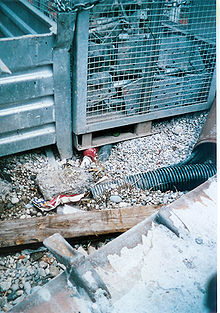Occupational safety
Occupational safety is the safety of employees at work, i.e. the control and minimization of dangers to their safety and health. It is therefore part of occupational health and safety within the meaning of the Occupational Safety and Health Act , which calls for measures to prevent accidents at work and work-related health hazards, including measures for the humane organization of work. The management of the safety and health protection of employees is one of the indispensable support processes of a company, primarily for humane reasons, but also from an economic point of view: Accidents and work-related illnesses cost both companies and society a lot of money. Empirical findings indicate that deficiencies in occupational safety and health protection can often be observed at the same time as deficiencies in the quality of products or services, that is, they suggest problems in company organization and management (e.g. Schliephacke 2008).
Anyone who, as an entrepreneur or as a representative of the entrepreneur (company superior, master, works manager, up to the management and the supervisory board), commissions or permits work that does not comply with the rules and standards of the respective industry , can be prosecuted personally under criminal and civil law .

Germany
The legal basis for occupational safety is the Occupational Safety and Health Act (ArbSchG), the Social Security Code SGB VII “Statutory Accident Insurance” and the law on company doctors, safety engineers and other occupational safety specialists (ASiG), which regulates the appointment and tasks of the above-mentioned specialists.
In Germany, state trade supervisory offices or offices for occupational safety and the statutory accident insurance providers ( employers' liability insurance associations and accident insurance funds in the German statutory accident insurance DGUV ) monitor work safety in a dual system . The latter issue accident prevention regulations that are binding law.
In recent years, occupational safety has moved away from the purely technical prevention of accidents and towards comprehensive prevention. This also means that the psychological factors of work are becoming more and more important and complement the technical aspects of occupational safety. Not least for this reason, instructions are an essential element of occupational safety and health protection. For example, Section 12 (1) of the Occupational Safety and Health Act requires that the insured be adequately and appropriately instructed during working hours. The manner and extent of instruction must be in an appropriate relationship to the existing risk situation and the qualifications of the insured person.
Occupational safety is combined with the requirements of ergonomics, humane work design and health protection to form a system-oriented approach to occupational safety. The current development also goes in the direction of the linking of occupational safety, quality and environmental protection management systems to an integrated management system, which is already provided for in some standards .
Switzerland
In Switzerland, the regulation of occupational safety according to the Accident Insurance Act (UVG) is taken over by the Swiss Accident Insurance Agency (SUVA) and the Federal Coordination Commission for Occupational Safety ( EKAS ).
The EKAS also trains specialists in occupational safety and safety engineers .
Since January 1st, 2000 companies insured with UVG have to adhere to the EKAS guideline on the involvement of occupational doctors and other occupational safety specialists (ASA). It was drawn up in accordance with the Accident Insurance Act and the Ordinance on the Prevention of Accidents and Occupational Diseases (VUV).
Austria
In Austria, occupational safety is regulated in the Employee Protection Act (ASchG).
There are safety officers (see SVP-VO), safety specialists (see SFK-VO) and occupational physicians .
- Occupational health and safety regulations in Austria
- Labor Inspectorate
- General accident insurance company
Problems in a globalized world of work
Occupational safety and health protection are based on ethical principles that are socially not implemented equally in practice in all industrial societies. Particularly in countries with emerging industries, the requirements of work safety, humane work design, environmental protection standards or the ban on child labor are apparently subordinated to monetary endeavors. Some basic rights, such as physical integrity and free development of the personality, do not appear to be firmly anchored in the general consciousness there. The perception of the marginal risk , i.e. the danger inevitably associated with an activity , has evidently shifted in favor of short-term pecuniary successes and to the detriment of the working people.
See also
- Osh
- Occupational Safety Act
- Occupational health and safety management
- SGU ((occupational) safety, health and environmental protection)
- Security management
- Workers' Memorial Day
- Trade Association (BGs)
- health Management
- Company health management (BGM)
- German Statutory Accident Insurance (DGUV)
- Federal Institute for Occupational Safety and Health (BAuA)
- European Agency for Safety and Health at Work (EU-OSHA)
literature
- Bruno Kürbiß: Responsible Care. Occupational safety and environmental protection in chemical plants. Europa-Lehrmittel, Haan-Gruiten 2008, ISBN 978-3-8085-7165-1 .
- Jürgen Schliephacke: Management knowledge of occupational safety . 3. Edition. Erich Schmidt Verlag, Berlin 2008
- OSH of A-Z . Haufe practical guide. 5th edition. 2009
- DGUV yearbook 2013/2014 . German Statutory Accident Insurance e. V.
Web links
- German Statutory Accident Insurance (DGUV)
- Federal Institute for Occupational Safety and Health (BAuA)
- European Agency for Safety and Health at Work (EU-OSHA)
- Program on Safety and Health at Work and the Environment (SafeWork). International Labor Organization
- International links on occupational safety
- EKAS regulations
Individual evidence
- ↑ On occupational safety in the 19th century, cf. Collection of sources on the history of German social policy from 1867 to 1914 , Department I: From the time when the Reich was founded to the Imperial Social Message (1867–1881) , Volume 3: Workers' protection , edited by Wolfgang Ayaß , Stuttgart a. a. 1996; Collection of sources on the history of German social policy from 1867 to 1914, Section II: From the Imperial Social Message to the February Decrees of Wilhelm II (1881–1890) , Volume 3: Workers' Protection , edited by Wolfgang Ayaß, Darmstadt 1998; Collection of sources on the history of German social policy from 1867 to 1914, III. Department: Expansion and differentiation of social policy since the beginning of the New Course (1890–1904) , Volume 3, worker protection , edited by Wolfgang Ayaß, Darmstadt 2005.


